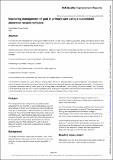Files in this item
Improving management of gout in primary care using a customised electronic records template
Item metadata
| dc.contributor.author | Moffat, Keith | |
| dc.contributor.author | McNab, Duncan | |
| dc.date.accessioned | 2018-06-05T14:30:09Z | |
| dc.date.available | 2018-06-05T14:30:09Z | |
| dc.date.issued | 2015 | |
| dc.identifier | 253267161 | |
| dc.identifier | e7de605b-782d-4ac5-b740-ad450db8da4c | |
| dc.identifier.citation | Moffat , K & McNab , D 2015 , ' Improving management of gout in primary care using a customised electronic records template ' , BMJ Quality Improvement Reports , vol. 4 , no. 1 . https://doi.org/10.1136/bmjquality.u204832.w2038 | en |
| dc.identifier.issn | 2050-1315 | |
| dc.identifier.other | RIS: urn:F7A97072226CE3083A05717708AE85BA | |
| dc.identifier.other | RIS: 136 | |
| dc.identifier.uri | https://hdl.handle.net/10023/13733 | |
| dc.description.abstract | It is known that the management of chronic gout in relation to serum uric acid (SUA) monitoring, allopurinol dosing, and lifestyle advice is often sub-optimal in primary care.[1] A quality improvement project in the form of a criterion based audit was carried out in an urban general practice to improve the care of patients being treated for gout. Baseline searching of EMIS confirmed that management of patients with gout who were taking allopurinol was not in line with current guidance. 51(40%) had a SUA checked in the past 12 months, 88(25%) had a SUA below target level, and gout lifestyle advice was not being recorded. An audit was performed to measure and improve the following criteria: •Monitoring of SUA levels in the past 12 months •Titration of urate lowering therapy to bring the SUA below target level •Lifestyle advice in the past 12 months An audit standard of 60% achievement at 2 months and 80% achievement at 4 months was set. The intervention consisted of a custom electronic template within EMIS which allowed guidance of gout management to be displayed and for data to be entered. All members of the team including GPs and administrative staff were educated regarding the intervention. This resulted in a sustained improvement over a 6 month period in all 3 components of the audit with 112(84%) having a SUA level checked, 79(51%) having a SUA below target level and 76(57%) receiving lifestyle advice. Although the improvement did not reach the audit standard in 2 of the criteria it would be expected that outcomes would continue given the systems changes which have been made. | |
| dc.format.extent | 447728 | |
| dc.language.iso | eng | |
| dc.relation.ispartof | BMJ Quality Improvement Reports | en |
| dc.subject | RA0421 Public health. Hygiene. Preventive Medicine | en |
| dc.subject | RZ Other systems of medicine | en |
| dc.subject | ZA4050 Electronic information resources | en |
| dc.subject | NDAS | en |
| dc.subject | SDG 3 - Good Health and Well-being | en |
| dc.subject.lcc | RA0421 | en |
| dc.subject.lcc | RZ | en |
| dc.subject.lcc | ZA4050 | en |
| dc.title | Improving management of gout in primary care using a customised electronic records template | en |
| dc.type | Journal article | en |
| dc.contributor.institution | University of St Andrews. School of Medicine | en |
| dc.identifier.doi | 10.1136/bmjquality.u204832.w2038 | |
| dc.description.status | Peer reviewed | en |
This item appears in the following Collection(s)
Items in the St Andrews Research Repository are protected by copyright, with all rights reserved, unless otherwise indicated.

